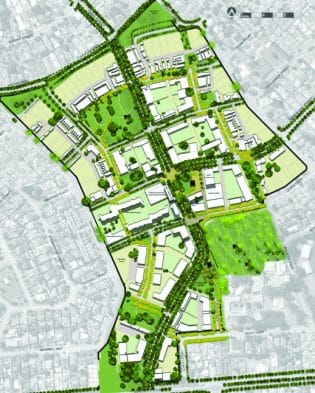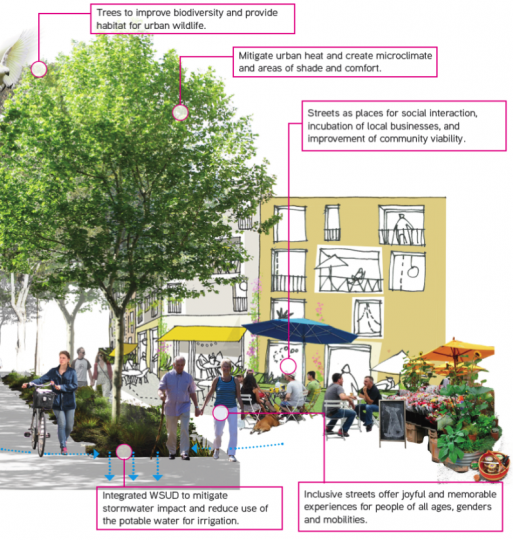Bentley – walking the road to a water sensitive city
The chance to redevelop a 25-hectare precinct within 10km of a capital city CBD does not come around very often. The Western Australian Housing Authority and the City of Canning have just such an opportunity in the Perth suburb of Bentley – 8km southeast of the city. And they mean to get it right.
The high-profile Bentley Regeneration Project is seen as an exemplar. With ambitious targets for affordability and sustainability, it aims to transform the locality into a highly valued neighbourhood – and, in doing so, redefine the delivery of infill development.
The suburb was originally built in the early 1970s, with a high concentration of public housing. John Savell, the Housing Authority’s Manager Major Projects, explains that while the high-rise Brownlie Towers and Radburn-design complexes were best-practice social housing models in their day, both have proved to be less desirable housing options.

The new development will incorporate at least 1500 new dwellings, public open spaces, and revitalised civic, community, commercial, and retail buildings. “Nothing about this project is business-as-usual,” says John. “Together with the City of Canning and the Bentley community, we are working to lift the whole area up and put a new stamp on this development.”
Ingredients for success
Given the Housing Authority’s mandate to provide housing for people on low incomes, affordability is fundamental. The challenge is getting the right proportion of public housing, affordable housing, and housing for private sale so that people want to buy and live in the area, explains John.
The other factor that will be critical to the development’s success is having a point of difference. “That, for me, is to be as green as possible,” he says. To this end, the Housing Authority hosted a research synthesis workshop in June 2015, facilitated by CRC for Water Sensitive Cities (CRCWSC), and involving participants from the City of Canning, CRC for Low Carbon Living, Department of Water, Water Corporation, and other consultants and stakeholders. Out of the two-day workshop came Ideas for Bentley, a research synthesis discussion paper, published by the CRCWSC in May 2016.
“Involving the CRCWSC legitimises what we are considering,” says John. “It gives us a platform to challenge business-as-usual. We are just public servants; to adopt a lot of the ideas for Bentley, and to challenge the business-as-usual model, we need the scientific results of the CRCWSC research.
“I need [CRCWSC Chief Executive, Professor] Tony Wong in front of my executive to sell this, because he’s the expert. I’m not. My job is to use the right experts at the right time. Having Tony work with decision makers from a range of agencies, we can start challenging the way we do things. Bentley can then become a trial for all the departments, not just ours.”
Changing the world through leading-edge research
Bentley is part of a growing portfolio of research synthesis projects that CRCWSC Regional Executive Director (Southern Region) and Research Synthesis Portfolio Leader Jamie Ewert has been involved with. “We’re starting to see the role that the CRCWSC can play in terms of endorsing leading-edge practice. There’s value in an independent, research-backed organisation helping to generate ideas and lending credibility to a project through the weight of its research,” he says.
“In the workshop, we ask: what would a bit of blue-sky thinking look like here? And then we work with stakeholders on how they might implement that.

“We’re helping to stimulate debate, putting as many different options on the table as we can because we know that will dictate what gets analysed and, consequently, what gets built.”
Ideas for Bentley discusses a range of options, including green walls to reduce heat-island effects, and use of stormwater to develop green infrastructure; through to deferring the augmentation of water and sewage infrastructure. The paper canvases measures such as a precinct-scale water grid into which various local water sources can be connected, and even a greywater-to-potable water pilot.
Meanwhile, the Bentley Regeneration Project provides an opportunity to validate some of the CRCWSC research in the Perth climate and context. “The research supports an application of these approaches in Perth, but there’s a huge amount of benefit in actually putting something in place and evaluating how it goes,” Jamie says.
Indeed, it’s anticipated that the project outcomes will reach far beyond this 25-hectare precinct. “We’re hoping the work we’re doing on Bentley provides answers and opportunities to incorporate into all future developments,” says John. “What we’re doing at Bentley is for Bentley, but it’s for what works, what doesn’t; what can be adopted without taking too much value out of the land. The successes will clearly have to be adopted into everything we do.”
Nicola Dunnicliff-Wells for the Mind Your Way team